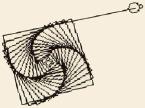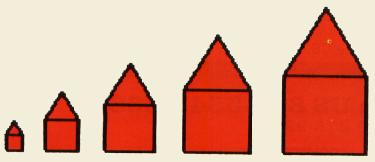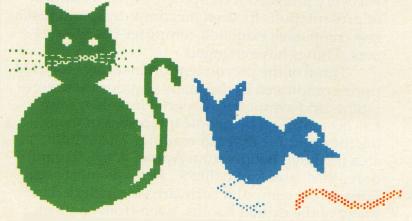FRIENDS OF THE TURTLE
David D Thornburg, Associate Editor

Ed Emberley's Drawing Procedures
Part of the appeal of turtle graphics is that it allows complex pictures to be built from simple building blocks. This feature arises from the fact that each shape description or procedure describes the shape itself, independently of its starting point or orientation. For example, once a square is defined with the procedure:
TO SQUARE :SIZE REPEAT 4 [FORWARD : SIZE RIGHT 90] END
the computer can use this procedure to create a square of any size at any starting location and orientation.
If the user has built up a set of useful geometric procedures, these can be combined to create more complex figures. If one also has a procedure for drawing triangles:
TO TRI : SIZE REPEAT 3 [FORWARD : SIZE RIGHT 120] END
then a procedure for drawing a house can be created from a combination of a square and a triangle:
TO HOUSE : SIZE SQUARE : SIZE FORWARD : SIZE RIGHT 30 TRI : SIZE END
This procedure can be used to create houses of different sizes.

Many turtle graphics enthusiasts create libraries of basic figures from which quite interesting pictures can be created.
As an active proponent of turtle graphics and procedural problem-solving, I was delighted to find Ed Emberley's independent discoveries along these lines.
Ed Emberley has written several books on illustration for children. His books of particular interest to readers of this column would include: Ed Emberley's Drawing Book of Animals, Ed Emberley's Drawing Book, Make a World, Ed Emberley's Big Orange Drawing Book, and Ed Emberley's Big Purple Drawing Book (all published by Little, Brown and Co.).
Mr. Emberley's illustration technique is built on the idea that, just as words are created from an alphabet of letters, pictures can be created from an alphabet of shapes. He shows how to create myriad figures using circles, rectangles, arcs, lines, triangles, and other simple pieces. By building the figure piece by piece, the young artist is never overwhelmed by trying to deal with the whole figure at once. The following series of illustrations (courtesy of Mr. Emberley) shows how one can create a clown's head almost entirely from circles and circle parts.
If you were to create this figure using turtle graphics procedures, you would need only procedures for a circle, an arc, a rectangle, and the squiggles for the hair.
Ed Emberley does not normally use a computer to create his illustrations. The clown figures shown on the next page are a happy exception to that, as he created them on an Apple computer using the KoalaPad touch tablet with the Micro Illustrator software. I am encouraging him to use Logo also to see how he likes it.

Just as Mr. Emberley's books can be a source of inspiration to those of us who build pictures using turtle graphics, they can also be wonderful tools for teaching procedural problem-solving – for teaching people how to solve larger problems by breaking them into bite-sized chunks. For this reason I encourage the use of his drawing books by teachers of computer programming. Not only are the children learning to solve problems with procedures, but they are also learning how to create charming illustrations at the same time.
I created the next figure myself to show that almost anyone can learn to make pictures in this manner.

For those of us who have been in the field a long time, the discovery of Mr. Emberley's excellent contributions is refreshing. Clearly, he is a Friend of the Turtle!